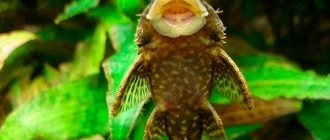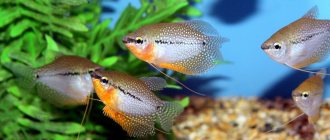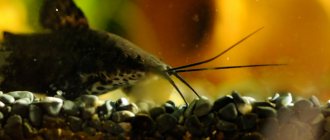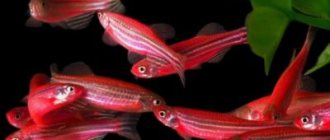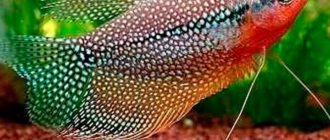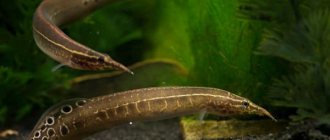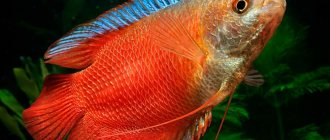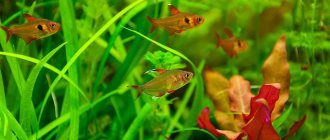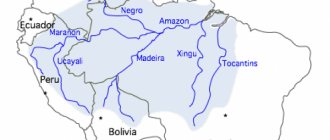Translated from Greek, “geophagus” means “earth eater.” The fish got its name from its unusual way of obtaining food. She takes bottom sand into her mouth, swallows the living creatures in it, and spits out soil particles. Geophagus red-headed (or tapajos) is a small, peace-loving species that prefers to live in a spacious aquarium, undemanding to care and living conditions.
Description
An adult can grow up to 25 cm, but at home the length rarely exceeds 17 cm. External characteristics:
- the body is elongated, flattened laterally;
- the back is quite high;
- unpaired fins are decorated with filaments - thread-like elongated outer rays.
The color deserves a separate description. It is changeable, depending on the condition of the individual and environmental conditions, and goes from silver to olive. The scales have a turquoise border. The head and frontal part are red. Lips light blue. The gills are olive with a golden tint. The iris of the eye is shiny red. The body is decorated with pale transverse stripes of olive color. In the center on each side of the body there is a black spot of almost circular shape. On the dorsal, anal, and ventral fins, stripes of rich red and blue colors alternate.
Habitat in nature
The habitat of the red-headed geophagus covers the northwestern rivers of South America: the Tapajos and its tributaries, the Magdalena, and the watercourses of the Maracaibo basin. The water in these sources is characterized by low acidity and is practically free of salts. But due to the large number of leaves, driftwood and algae rotting at the bottom, it has a dark color.
When living in nature, geophaguses try to stay closer to the shore, where the bottom is sandy or muddy. They hide from predators in holes in snags and between stones.
The species is gregarious. Young animals gather in groups of 10–20 individuals. Older individuals stay away and prefer to swim in pairs.
Care and maintenance
To keep tapajos, an aquarium of 90x40x30 cm is enough if the flock is small. But the optimal size is 120x40x30 cm, and the volume is 140 liters. If there are 12 or more individuals in a flock, then the volume should be at least 250 liters.
Water parameters
Geophagus is unpretentious to water conditions and easily adapts to any water parameters. It is recommended to install:
- temperature 26 - 28°C;
- acidity 5.5 – 7.5 pH;
- hardness 20 – 180 ppm.
It is advisable to create a flow effect in the aquarium, so the fish will feel more comfortable. To saturate the water with air and purify it, a powerful filter and aeration system must be installed.
Lighting
Light intensity is not important for geophaguses. But it is advisable to make the light not too bright so that the fish do not get scared.
Plants
Vegetation may cause problems. It must be taken into account that tapajos dig the soil and can uproot plants. To prevent this from happening, it is recommended to place potted plants in the aquarium. You can also purchase species that can grow on driftwood (for example, Java moss). The fish do not nibble the leaves.
The best option for soil is river sand. You should not put pebbles; fish trying to rummage through them can injure their mouths.
Decor
When setting up an aquarium, create an environment reminiscent of natural habitat conditions. Place driftwood and several large stones.
Geophagus brasiliensis (lat. Geophagus brasiliensis)
As the name suggests, this group is native to the east and southwest of Brazil, where the fish prefer reservoirs with a sandy bottom. There are also artificially created populations of Brazilians, for example, in Australia, Taiwan and the Philippines.
Appearance. These earth-eaters differ from their fellows by having a less laterally compressed and more curved body, smaller eyes and a higher mouth. They are quite large and can grow up to 30 cm.
Editorial: Tetra penguin
The body color is emerald-turquoise, gray-yellow or even red-brown. There are many pearly dots on the yellow-green or brown fins. Each scale is decorated with a small bluish-green spot.
There are big differences between females and males. The male is large, with long fins, his head is sloping and has a fatty bump.
During spawning, a large black spot appears on its side and a black stripe passes through the eye.
Containment conditions and compatibility
In an aquarium they prefer to be in the lower layers of water. Periodically they dig up the soil very hard. They are kept in flocks or pairs. A reservoir with a view is recommended. The pack has a very strict hierarchy. Males are aggressive towards everyone: other fish, their own kind and even their own females. Aggression especially intensifies when defending territory and during the spawning period.
In this regard, the aquarium simply must be equipped with a large number of small and large, but most importantly reliable shelters.
To keep Brazilian geophagus, you will need an aquarium with a volume of at least 300 liters. Acceptable indicators for water: temperature 16-30 (optimally 20-25) degrees, acidity 5-7, hardness 5-15. The water needs to be continuously filtered and a third replaced weekly. Sand is placed at the bottom. It is better to select plants that are strong, with powerful roots and tough leaves. They can be planted in pots and weighed down with stones on top. Place floating plants on the surface.
You can feed live, frozen or dry sinking food (brine shrimp, bloodworms, etc.). The main thing is that the diet is varied, nutritious and rich in vitamins. If fish are poorly maintained and fed, growth retardation and a number of diseases occur.
Geophagus brasiliensis.
Reproduction
Brazilian geophaguses reproduce differently from others. It is almost impossible to make a pair of adult fish, since the male does not accept the female, pursues her and can even kill her. It's better if he's younger and smaller. Water parameters do not affect reproduction, but breeders still recommend optimal parameters: t 26-32°C, dH up to 10°, pH 6-7.2.
The average duration of spawning is from 0.5 to 1 hour. The female lays eggs in quantities of about 200 (for the first clutch) or thousands of eggs (for subsequent clutches) on a stone or other cleaned flat surface. After three or four days, the larvae hatch, and the mother immediately transfers them to a pre-dug hole in the sand. She can hide them several times until the fry begin to swim on their own.
Care lasts about three months and consists of accompanying a school of fry, lifting food from the bottom and grinding large pieces. At first it is carried out only by the female, and later the male also joins.
Competition for custody may even arise between them, which sometimes ends in the death of the female. To avoid this, juveniles are isolated from adults. But this is only possible after the babies switch to independent feeding.
Young fish are inconspicuous, painted in gray-green tones. At first they are fed with rotifers, nematodes, Cyclops nauplii, and micromines. After 6-9 months they grow to 10 cm and are already capable of producing offspring.
As you can see, aquarium earth eaters vary in size, body shape and color, behavior and habits. Nevertheless, many of them are very loved and sought after by aquarists all over the world, including the aggressive Brazilian. Perhaps it’s all about their diversity, unusual and bright appearance, interesting behavior, long life expectancy and not too complex content. If you love cichlids, try keeping Geophagus. I think it will be a useful and interesting experience!
Feeding
Aquarium fish are not picky when it comes to food. Willingly consumes live and dry food. The daily diet should be varied, with the obligatory inclusion of plant foods. You can give cereals, leafy greens scalded with boiling water, shellfish meat, and boiled vegetables.
The fish should not be allowed to get fat. Feeding is carried out 3 or 4 times a day, the portions are small.
It is interesting to note that geophagus do not rise to take food, but wait for it to fall to the bottom. Then they pick it up from the ground.
Geophagus Steindachner
These earth-eaters, up to 15 cm long, live in the Cauca and Magdalena river basins. They have an olive or brownish coloration, with dark stripes appearing on it during spawning. The dorsal fins have red stripes. All unpaired are brown with yellow spots. The back is curved more than the abdomen. Dominant males have a brown bump on their forehead. During the spawning period it increases and becomes brighter. Females do not have cones; their coloring is more modest.
Geophagus Steindachner are fairly calm fish that get along well with neighbors of a similar size. It is better to keep them in flocks, where there should be more males than females. An aquarium with a minimum volume of 150 liters is suitable for fish. Sandy soil is used. The bottom is decorated with driftwood, grottoes and large stones. Algae are selected with a powerful root system or waterfloating ones. The water parameters are as follows:
- temperature - from 24 to 30º C;
- acidity - 6.5−7 Ph;
- hardness - 5−15 dH.
The fish are given small portions of food several times a day. Geophagus eat plant and animal food: daphnia, bloodworms, larvae, finely chopped vegetables and lettuce. Fish become sexually mature at 8-10 months. Females develop ovipositors, and males become brighter in color. Courtship in fish takes place in a unique way: all day long the male either spreads his tail in front of the female or chases her throughout the aquarium.
Editorial: Mastacembelus thailandis
Then the fish calm down and together prepare a platform for spawning. The female immediately takes the released eggs and milk into her mouth. Fertilization also occurs there.
Breeding
Breeding tapajos is a simple undertaking. Sexual maturity in representatives of the species occurs at 8–10 months (in males a little earlier).
Before spawning, the color of the male becomes more saturated. The gentleman drives away all fish, both his own species and others, from the female. To reproduce, the formed pair must be moved to a spawning tank.
The female lays 100–300 eggs. The male fertilizes. The female can leave the eggs lying on the bottom, or she can carry them in her mouth. After 3–4 days, the fry hatch.
Parents take care of the fry, so they do not leave them. The fry constantly stay close to their father and mother; sensing danger, they hide in their mouths. Parents, digging in the ground, obtain food for their offspring.
The fry are fed with plankton and crushed flakes.
Compatibility
Shy, they stay together in the aquarium; from time to time the males stage a show of strength, but without injuries or fights. Surprisingly, redheads get along even with neons and do not touch the fish if it is at least a few millimeters in length.
The list of compatible fish will be endless, but it is best to keep it with fish living in the Amazon - angelfish, corydoras, small cichlids.
They become aggressive during spawning, defending their nest.
Diseases and prevention
The immunity of geophaguses is strong. How long representatives of the species live depends on feeding and living conditions. Life expectancy is several years.
Tapajos get sick only if the living conditions are not acceptable. Diseases characteristic of cichlids occur. The sick individual is immediately separated from the healthy ones.
The most common reason for decreased immunity and death of pets is poor water quality, high content of nitrates and ammonia. For prevention, it is necessary to maintain proper filtration and aeration, and do not forget about periodic water changes.
If proper water quality is maintained, geophaguses live a long time, delighting with their beauty and original appearance.

